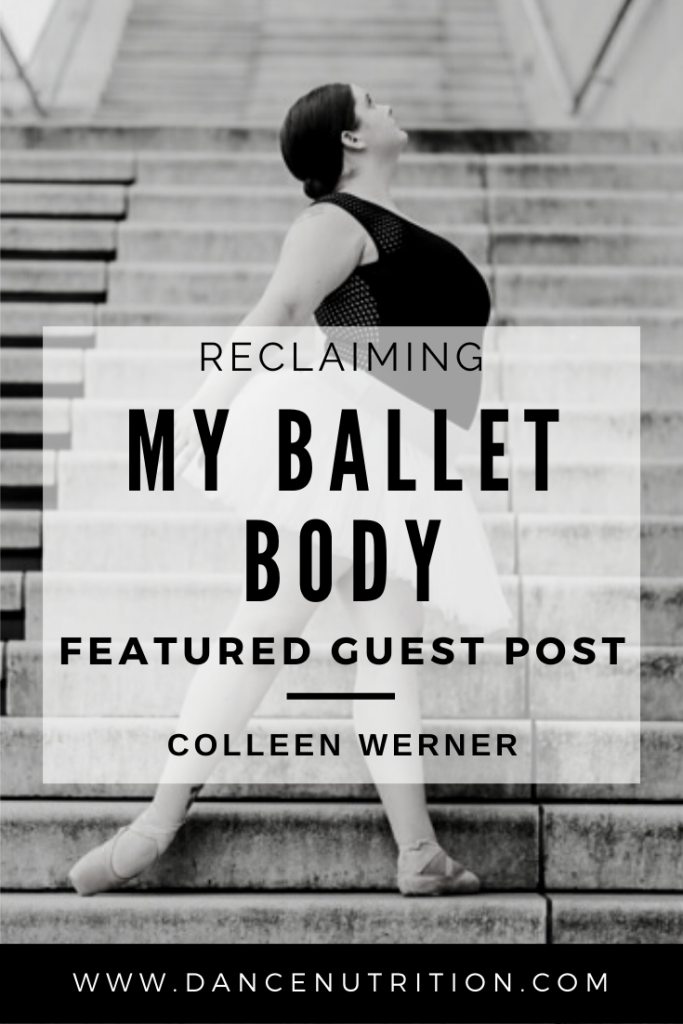It’s no secret that the dance world, especially the ballet world, talks about bodies and food in a way that is far from healthy. 1 in 5 dancers have struggled with an eating disorder, and I am one of them.
Dance wasn’t my only reason for developing anorexia nervosa. Eating disorders are complex biopsychosocial mental health conditions with a multitude of contributing factors. For me, some of those contributing factors were genetics, my ballet training, my history of dieting (which started at only 10-years-old), and trauma.
Ballet alone didn’t cause my eating disorder. It did, however, create a socially acceptable atmosphere for me to engage in eating disorder-like behaviors. Not only did ballet make it okay for me to engage in my eating disorder, but it also encouraged me. As my body shrunk, I was praised. I started getting more attention in class and more featured roles. The reality, however, is that I was slowly killing myself. I was constantly lightheaded in class, and all I could think about was my next meal and my body. Ballet was no longer about my love for the art — it was about conforming to a standard and shrinking my body.
Ballet was no longer about my love for the art — it was about conforming to a standard and shrinking my body.
At 19, I began the journey towards recovery. At first, learning to navigate the dance world felt impossible. I still felt immense pressure to maintain the body that my eating disorder gave me, and learning to fuel my body adequately seemed like the most challenging thing ever. Gradually, things got easier, and I started to find the motivation to get my life back.
In 2017, I started the #BopoBallerina movement to encourage positive body image, body diversity and eating disorder awareness in the dance world. While creating this movement helped me feel more at home in the ballet world, eventually, I realized that I needed to take some time away from dance in order to fully heal.
During my time away, I discovered the Health At Every Size (HAES®) approach. According to the Association for Size Diversity and Health, HAES rejects both the use of weight, size, or BMI as proxies for health, and the myth that weight is a choice. According to the HAES paradigm, health exists on a continuum — it’s not as simple as just being “healthy” or “unhealthy.” Health looks different for everyone, and health isn’t a moral imperative. Someone’s health status doesn’t define their worth or value as a human. In addition, body diversity is natural — we aren’t all meant to look the same.
…body diversity is natural — we aren’t all meant to look the same.
Over the past year, I’ve returned to ballet. As a plus-sized woman, getting back into the studio was intimidating. It’s a constant challenge not to judge myself and to give my body the respect it deserves. In a world ruled by the thin ideal, it’s hard not to feel alone in a larger body. From dancewear brands only catering to thin bodies to companies filled with primarily thin dancers to Instagram feeds filled with thin ballerinas, it can be hard to see anything else. The reality is, however, that just as body diversity exists in the world as a whole, it exists in the dance world too. People of all different body types and sizes deserve to feel welcome and appreciated in the ballet world. The “ballerina body” shouldn’t be a singular image that pops up in someone’s brain.
People of all different body types and sizes deserve to feel welcome and appreciated in the ballet world.
I’m incredibly grateful to now be in an environment that’s affirming and appreciative of my unique ballet body and me. I currently take open classes at Nashville Ballet as well as at The Dancer Project Conservatory, and this December I am performing in The Dancer Project’s production of The Nutcracker. Returning to the stage to perform as a ballet dancer is an incredible gift, and I’m so grateful to be at a point in my healing journey where I can dance because I love it, not because I’m trying to change my body. I share my journey on Instagram, and being able to connect with others on similar paths is truly special.
Incorporating ballet back into my life in a way that affirms my healing and my values is extremely fulfilling. I’m currently a graduate student on track to attain a Masters in Clinical Mental Health Counseling. I aspire to become a therapist for the treatment of eating disorders and trauma. My ultimate goal? To create an eating disorder treatment program for dancers. I’m excited to continue seeing how ballet will change my life and how the ballet world will change for the better.

Colleen Werner is a mental health advocate, public speaker, eating disorder recovery coach, and eating disorder therapist-in-training. Her personal experiences with anorexia nervosa, severe major depressive disorder, generalized anxiety disorder, and PTSD led her to want to turn her struggles around to both inspire and help others in similar situations.


